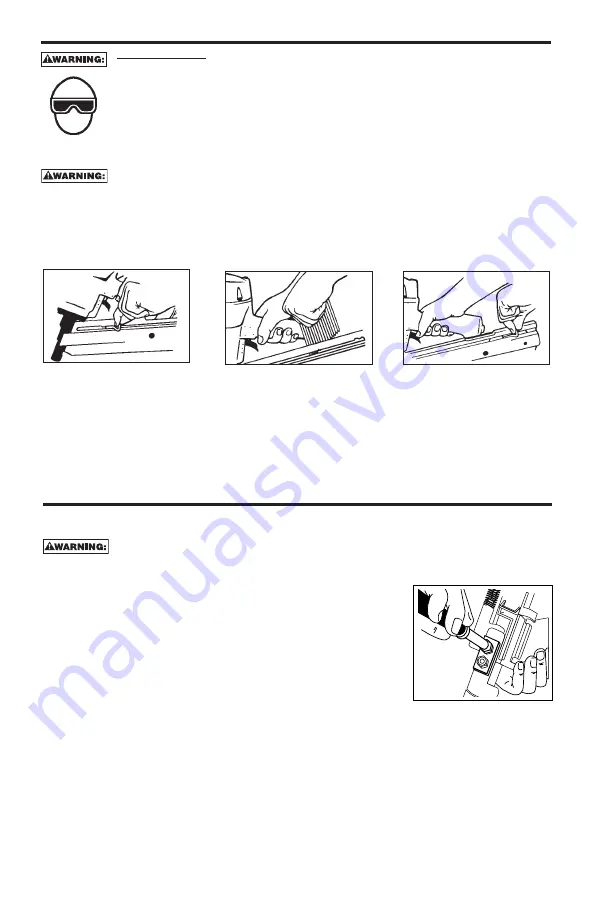
-6-
1. Open the magazine: Pull pusher back to engage latch.
2. Load Nails: Hold nailer down with magazine tilted downward. Insert sticks of nails
3. Close Magazine: Release latch by pulling latch tab and pusher together slightly to disengage, slide
pusher against nails.
NOTE: Use only nails recommended for use in Bostitch N95162 series nailers or nails which meet
the Bostitch specifications.
LOADING THE N95162
EYE PROTECTION which conforms to ANSI specifications and provides protection against
flying particles both from the FRONT and SIDE should ALWAYS be worn by the operator and
others in the work area when connecting to air supply, loading, operating or servicing this
tool. Eye protection is required to guard against flying fasteners and debris, which could
cause severe eye injury.
The employer and/or user must ensure that proper eye protection is worn. Eye protection
equipment must conform to the requirements of the American National Standards Institute,
ANSI Z87.1 and provide both frontal and side protection. NOTE: Non-side shielded
spectacles and face shields alone do not provide adequate protection.
TO PREVENT ACCIDENTAL INJURIES:
• Never place a hand or any other part of the body in nail discharge area of tool while
the air supply is connected.
• Never point the tool at anyone else.
• Never engage in horseplay.
• Never pull the trigger unless nose is directed at the work.
• Always handle the tool with care.
• Do not pull the trigger or depress the trip mechanism while loading the tool.
FASTENER DEPTH CONTROL ADJUSTMENT
The Fastener Depth Control Adjustment feature provides control of the nail drive depth from flush with or just
above the work surface to shallow or deep countersink.
TO ADJUST THE FASTENER DEPTH CONTROL:
DISCONNECT TOOL FROM AIR SUPPLY BEFORE ATTEMPTING ANY PARTS DISASSEMBLY AND
BEFORE CHANGING THE WORK CONTACTING ELEMENT ADJUSTMENT.
1. With air pressure set, drive a few fasteners into a representative material
sample to determine if adjustment is necessary.
2. If adjustment is required, disconnect air supply.
3. If adjustment to the drive depth is required, measure the difference in depth
between the nail as driven in the sample material and the desired drive.
The depth control should be changed by the same amount. To reduce the
drive depth, the work contacting element should be lengthened. To obtain a
deeper drive, the work contacting element should be shortened.
4. Note the level at which the depth control is assembled. Decide what
adjustment is required to achieve the length change determined in (2) above. The dashes on the front of
the depth control are evenly spaced .08” (2mm). Zero would have the deepest countersink and 12 may
leave the nail head above the work. The tool is shipped from the factory on setting “0”.
5. To make the adjustment, use a 10mm wrench or nut driver to loosen the (2) elastic stop nuts on the depth
control approximately 2 full revolutions. It is not necessary to remove these nuts. Move the lower portion of
the depth control to the desired height and tighten the nuts. Do not overtighten. Check that the work
contacting element operates freely without sticking or binding.
6. Reconnect air supply and drive a few fasteners in a sample of material to determine if adjustment is correct.
If further adjustment is necessary, disconnect air and repeat above.
1.
2.
3.
Summary of Contents for N95162
Page 32: ......





































